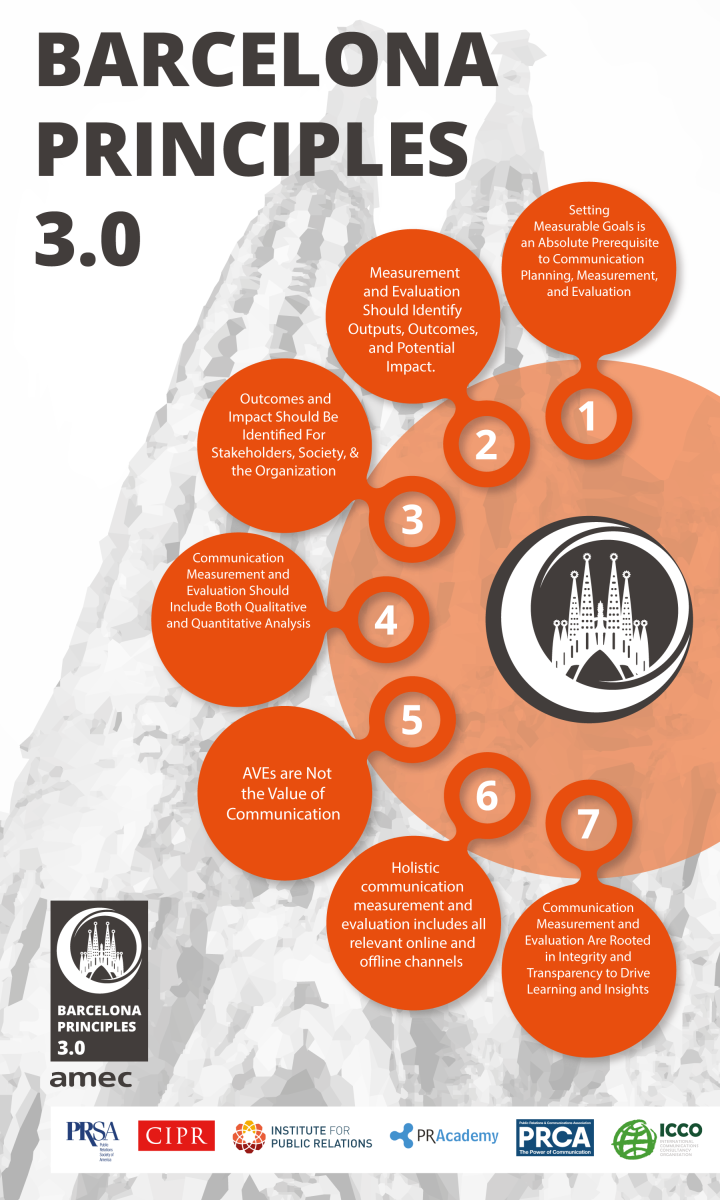Barcelona Principles 3.0 – what they are and why Public Relations buyers should ask if they’re being used

In a previous post, I explained how the creation of Barcelona Principles for communication measurement in 2010 helped solve the problem for communicators and those paying them of knowing whether and how much the communication done has met the Objectives set.
Since then they’ve been the global gold standard for communication measurement and evaluation and have been updated twice by AMEC (the International Association for the Measurement & Evaluation of Communication).
The problem is not everyone working in communication is working to that standard. Or, in many cases, even knows about it. And that leads to problems for executives and those who communicate for them.
In 2023, a study by Champion Communications found 82% of B2B CEOs felt the PR measurements used in their organisation weren’t useful.
But more than half (66%) of senior marketing decision-makers reported their PR measurement was "extremely accurate."
So why the disconnect?
Business Objectives
Firstly, the marketers are choosing to measure things which don’t necessarily all clearly relate to the things CEOs have as Business Objectives/goals – the things they measure with KPIs – so they’re not useful in telling the CEOs how the Public Relations has helped with the things they focus on achieving.
The study found the marketers were using the following, which I’ll rate on relevance:
- Using Social media engagements (47%) – fine as an Out-take of communication (what audiences do with or take out of your communication), but not as an end in itself – it needs to lead to an Outcome (effects your communication has on audiences)
- Website visits (45%) – a useful Out-take, but only relevant if it leads to target Outcomes
- Instinct/Anecdote (45%) – not a valid metric
- SEO Rankings (44%) – a useful Output, but only if it results in target audiences finding your website on search engine results pages and clicking on the link to visit your site
- Brand Awareness studies (40%) – a useful Out-take, but only useful if target audiences are prompted by it to be interested in your offer and the communication elicits a desire to do what you want and take action to do so
- Downloads (36%) – a useful Out-take, but only if the content spurs action creating achievement of an Outcome
- Share of Voice (35%) – another Output of communication but only useful if used to create Out-takes and Outcomes
- Backlinks (32%) – like SEO and Share of Voice as an Output, but only if they’re used to create Outcomes
What you should be doing
Setting Business and Communication Objectives for communication, include Public Relations, which clearly link to helping achieve the organisation’s stated goals is at the heart of the Stockholm Accords agreed by the World Public Relations Forum in 2010.
Following on logically from that is the question of how to measure whether those Business and Communication Objectives set have been achieved or not as a result of the activity done.
That’s where Barcelona Principles, created the same year by AMEC, come in.
Barcelona Principles 3.0
Version 3.0, defined in 2020, lays out seven principles to be followed when setting metrics for measurement and evaluation of Business and Communication Outcomes.
- Setting goals is an absolute prerequisite to communications planning, measurement, and evaluation.
- Measurement and Evaluation should identify Outputs, Outcomes, and potential Impact (the results that are caused in full, or in part, by your communication).
- Outcomes and impact should be identified for stakeholders, society, and the organization. Measuring for society is impractical for small or medium-sized organisations without the budget required for the market research required to measure this.
- Communication measurement and evaluation should include both qualitative and quantitative analysis. So things like perception as well as things easily measured in numbers.
- AVEs are not the value of communication. AVE (Advertising Value Equivalence – what it would have cost you to buy the space taken up by editorial coverage, multiplied by 3 to allow for the value of the third-party endorsement by trusted media choosing to write about you) was one of the most common ways of measuring the value of media coverage and is still used by some practitioners. It’s popular because it makes calculating the ROI of the activity simple, but it doesn’t demonstrate any link to achievement of organisation goals.
- Holistic communication measurement and evaluation includes all relevant online and offline channels.
- Communication measurement and evaluation are rooted in integrity and transparency to drive learning and insights.
The taxonomy usefully gives examples of which stage common steps in communication fall into, metrics which are appropriate for measuring them and methods of evaluation for them.
What you should do
So if you’re paying someone to do Public Relations for you in pursuit of certain business goals, to ensure you know the true value to your organisation of what’s been done you need to find out:
- What they propose to do
- How those things will influence your target audiences to do what you want – typically changing their behaviour or beliefs
- What SMART Business and Communication Outcomes they propose to set to measure the contribution of the activities towards your organisational goals
- What Barcelona Principles 3.0-compliant metrics and methods they propose to use to measure and evaluate the effectiveness of the activities in prompting the target Business and Communication Outcomes
When I was doing my OU MBA at the start of this century, it was said in the Marketing section of the B800 Foundations of Senior Management course that “Marketing is too important to leave to the Marketing Department” i.e. executives need to understand it enough to ask informed questions about what’s being suggested. I agree.
The same is true about Public Relations and especially how its effectiveness is being measured and evaluated. That’s why you need to check if the communicators you’re paying are following Barcelona 3.0 Principles.
© Alan S. Morrison, 2025
Alan S. Morrison gained his Master of Business Administration (MBA) postgraduate degree from the Open University Business School in 2003 and is one of the case studies for it.
At that time he was working as a senior Sub-Editor in a Scottish newspaper, following 15 years as a Reporter, Chief Reporter and News Editor.
In 2012, Alan launched his own communications company, ASM Media & PR, after entering Public Relations via agencies and credits the knowledge and skills he gained on his OU MBA as being instrumental in helping him career-change successfully.
His award-winning clients include a rugby charity with a Royal patron, Scotland’s largest independent lift company and a vintage lifestyle brand whose products are seen in scores of Hollywood movies and global TV shows.
The marketing campaign Alan created and helped execute for St Andrews Business Club was a Finalist in the 2019 Fife Business Awards.
Alan’s LinkedIn profile is here. Go here to find out more about his work.
May 2025
Would you like to contribute an article towards our Professional Knowledge Bank? Find out more.

